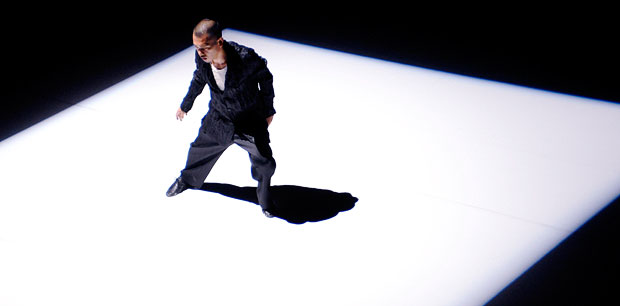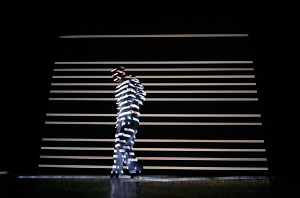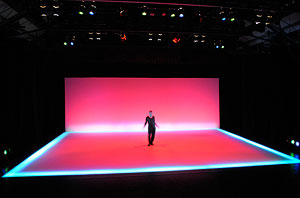
Hiroaki Umeda takes charge not only on the choreography and dance, but also the optical designs and acoustic aspects of his stage productions. Interested in the effects of visual impact on the audience, he creates stimulating settings of intense lights and colors, which he synchronizes with his own improvised dance. The style that he creates is especially acclaimed in Europe and the USA. Most recently he was awarded an Honorary Mention for Adapting for Distortion at the Ars Electronica media art festival (digital music & sound art category) and enjoys a growing international reputation in various fields beyond the boundaries of dance.


left: “Accumulated Layout” (2007) photo: Shin Yamagata
top-right: “Adapting for Distortion” (2008) photo: Alex
bottom-right: “Haptic” (2008) photo: Shin Yamagata
Light, sound, and the human body as equivalent elements on stage
Lighting and sound are fundamental components of a stage production. In Umeda's works, they don't play a subordinate role in the presentation of dance, but they are equivalent elements on a level with the third component that is the artist’s body. These performances in which Umeda illustrates such abstract ideas as colors or lines based on his own “emotions”, and establishes connections between light, sound and the human body, are sometimes likened to installations.
Controlling the viewer's sense of vision
How do we have to define dance in an age where various levels of “reality” mix against a backdrop of imagery and network environments? As if raising protest against the conception of dance as a form of art with an emphasis on the sense of vision, Umeda calls his style “visual performance” to highlight an even greater excess of sight. Aiming to control the images received by the viewer as visual information – separately from the representation of the body in performing arts – Umeda works with an extraordinarily ambitious and challenging attitude. He analyzes the body as a receptor of light, and composes pieces out of lights and colors for his audiences to experience the criticality of perception.
The portability of making flexible use of media technology
Hiroaki Umeda continues to present his works at the world's leading festivals and performing arts venues. His compact tour setup – including not more than his own body and a computer – represents a very up-to-date style that surely benefits from the improvement and popularization of media technology in general. The multi-angle approach pursuing methods of realizing imagery and sound ideas in addition to choreography and dance hints at a contemporary type of performance that impresses with a high level of “portability”.
